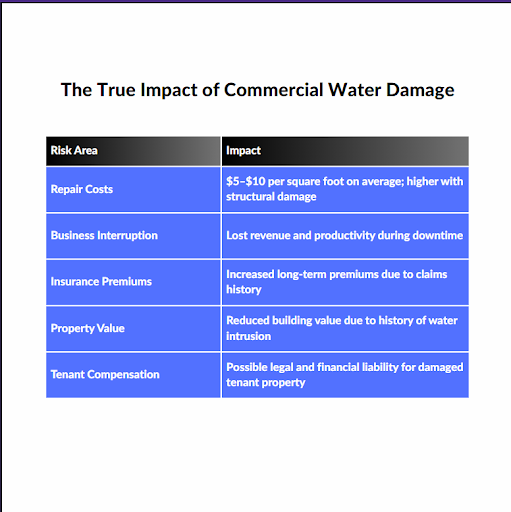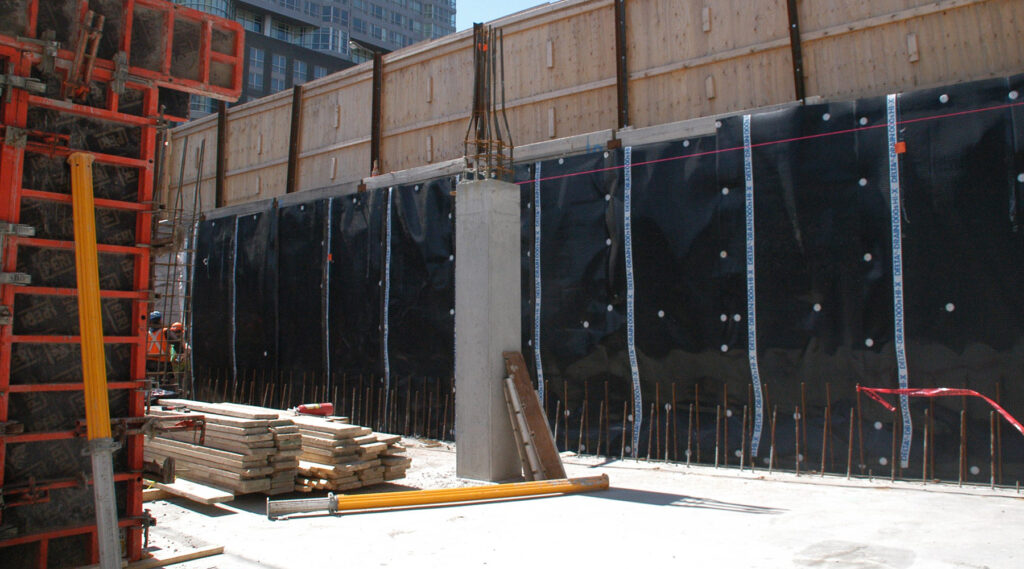Water intrusion represents one of the most significant threats to commercial buildings, capable of causing extensive structural damage, compromising building integrity, and creating hazardous conditions for occupants. From foundation deterioration to mold growth and electrical system damage, the consequences of inadequate waterproofing can be devastating both structurally and financially.
At Tri-State Waterproofing, we’ve spent decades helping commercial property owners protect their investments through effective waterproofing solutions. As a commercial waterproofing contractor, in this comprehensive guide, we will help you explore seven proven commercial waterproofing approaches that prevent costly structural damage and extend the lifespan of your building.
The High Stakes of Commercial Water Damage

Before dipping into clear solutions, it’s essential to understand what’s at risk when commercial buildings lack appropriate waterproofing:
Financial Impact
Water damage in commercial buildings carries significant financial consequences:
- Repair costs: Commercial water damage repairs average $5-$10 per square foot, with extensive structural damage pushing costs much higher
- Business interruption: Rest during repairs leads to lost income and productivity
- Increased insurance premiums: Claims history can drive up long-term insurance costs
- Decreased property value: History of water issues negatively impacts building valuation.
- Tenant compensation: Potential liability for damage to tenant property or business interruption
“The cost of proper waterproofing is minimal compared to the expense of addressing water damage after it occurs,” explains a commercial property specialist at Tri-State Waterproofing. “We typically find that preventative waterproofing represents just 2-5% of what remediation and repairs would cost after significant water intrusion.”
Structural Consequences
Water infiltration attacks a building’s structural integrity in multiple ways:
- Concrete deterioration: Water penetration leads to cracking, spalling, and reduced structural capacity
- Steel reinforcement corrosion: Moisture causes rebar to rust and expand, further damaging concrete
- Wood rot: Structural timber elements deteriorate when exposed to moisture
- Soil destabilization: Water saturation around foundations can cause settling or shifting
- Freeze-thaw damage: In colder climates, water expands when frozen, creating additional pressure and cracking
Health and Safety Concerns
Beyond structural issues, water intrusion creates serious health and safety risks:
- Mold & mildew growth: Grows within 24-48 hours of water exposure
- Poor indoor air quality: Affects occupant health and comfort
- Slip hazards: Water accumulation creates dangerous conditions
- Electrical system damage: Moisture in electrical systems poses fire and shock risks
- Building material contamination: Waterborne pollutants can affect building materials
Solution #1: Foundation Waterproofing Systems
The foundation represents your building’s first string of protection against groundwater intrusion. Comprehensive foundation waterproofing is essential for preventing water migration into basements, crawl spaces, and ground-floor areas.
Key Components:
- External waterproofing membranes: Applied to exterior foundation walls to prevent water penetration
- Drainage boards: Create pathways for water to flow away from foundation walls
- Boundary drainage systems: Collect & redirect groundwater away from the foundation
- Sump pump systems: Remove accumulated water from around the foundations
- Hydrostatic pressure relief systems: Reduce water pressure against foundation walls
Application Considerations:
For existing buildings, foundation waterproofing typically requires excavation to access exterior foundation walls. While this represents a significant investment, it provides the most comprehensive protection against groundwater intrusion.
For new construction, as a commercial waterproofing contractor, we recommend that foundation waterproofing should be integrated into the building design from the beginning, with careful attention to membrane selection, drainage provisions, and connection details.
Solution #2: Exterior Wall Waterproofing
Commercial building envelopes must effectively manage water that contacts exterior walls through rainfall, splashing or wind-driven moisture. Proper exterior wall waterproofing controls water infiltration while allowing the wall system to breathe and remove any trapped moisture.
Key Components:
- Water-resistant barriers (WRBs): Sheet or fluid-applied membranes that prevent water penetration
- Flashing systems: Direct water away from vulnerable areas like windows, doors, and transitions
- Sealants and joint treatments: Prevent water entry at material transitions and movement joints
- Vapor-permeable systems: Allow walls to dry while preventing liquid water intrusion
- Drainage planes: Create pathways for water to exit the wall system
Application Considerations:
As a commercial waterproofing contractor, exterior wall waterproofing can be incorporated during new construction or renovation projects. For existing buildings, options include coating systems, injection treatments, and replacement of failed sealants and flashings. The appropriate approach depends on the wall construction type (masonry, concrete, EIFS, metal panel, etc.), local climate conditions, and building exposure.
Solution #3: Roof Waterproofing and Drainage
The roof represents the largest horizontal surface exposed to precipitation and is often the source of the most significant water intrusion issues in commercial buildings. Comprehensive roof waterproofing combines multiple elements to ensure water is effectively managed.
Key Components:
- High-performance membrane systems: Including modified bitumen, single-ply, or fluid-applied options
- Proper slope and drainage: Ensures water doesn’t pond on roof surfaces
- Roof penetration detailing: Careful waterproofing around HVAC equipment, vents, and other penetrations
- Expansion joint treatments: Accommodates building movement while maintaining waterproof integrity
- Regular maintenance programs: Preserves waterproofing performance throughout the roof’s lifespan
Application Considerations:
Roof waterproofing options vary based on roof type, building use, climate conditions, and budget considerations. For existing buildings, options range from complete roof replacement to restoration systems that extend the life of the current roof while improving waterproofing performance.
Solution #4: Below-Grade Waterproofing
Below-grade spaces in commercial buildings present unique waterproofing challenges due to constant ground moisture exposure and hydrostatic pressure. Effective below-grade waterproofing requires specialized systems designed for these demanding conditions.
Key Components:
- Positive-side waterproofing: Applied to the exterior of below-grade walls before backfilling
- Negative-side waterproofing: Applied to interior surfaces when exterior access isn’t possible
- Waterstop systems: Prevent water migration through concrete joints
- Crystalline waterproofing: Penetrates concrete to form water-blocking crystals within the pore structure
- Bentonite clay systems: Expand when wet to create impermeable barriers
Application Considerations:
For new construction, as a commercial waterproofing contractor, we recommend that positive-side (exterior) waterproofing provide the most effective protection and should be incorporated into the building design. For existing structures, negative-side (interior) waterproofing offers a practical solution when exterior excavation isn’t feasible. The appropriate system depends on groundwater conditions, soil composition, building use, and accessibility.
Solution #5: Plaza Deck and Podium Waterproofing
Many commercial buildings incorporate occupied spaces below plaza decks, parking areas, or landscaped podiums. These areas require specialized waterproofing systems that can withstand traffic, planting, or other surface uses while providing complete protection to the spaces below.
Key Components:
- Traffic-bearing membranes: Withstand vehicular or pedestrian traffic without damage
- Protection courses: Shield waterproofing membranes from damage during construction
- Root barriers: Prevent landscape plantings from compromising waterproofing
- Drainage composites: Facilitate water movement to collection points
- Expansion joint systems: Accommodate movement while maintaining waterproof integrity
Application Considerations:
Plaza and podium waterproofing must be carefully integrated with structural design, landscape architecture, and building systems. The appropriate system depends on the intended surface use, structural design, climate conditions, and maintenance considerations. For existing plazas, rehabilitation options range from targeted repairs to complete reconstruction, depending on the condition of the existing waterproofing and the extent of any damage.
Solution #6: Joint and Penetration Treatments
Building joints and penetrations represent vulnerable points in any waterproofing system. Proper treatment of these areas is essential for maintaining the integrity of the overall waterproofing approach.
Key Components:
- Expansion joint systems: Accommodate building movement while maintaining waterproof integrity
- Control joint treatments: Prevent water migration through planned concrete cracking
- Pipe and conduit penetration seals: Create watertight connections around building services
- Structural connection details: Address complex junctions between different building elements
- Transition membranes: Maintain continuity between different waterproofing systems
Application Considerations:
Joint and penetration treatments must be compatible with adjacent waterproofing systems and accommodate expected movement. The appropriate solution depends on joint width, movement expectations, exposure conditions, and accessibility for future maintenance.
For existing buildings, joint rehabilitation often provides a cost-effective approach to resolving water intrusion without disturbing intact waterproofing areas.
Solution #7: Preventative Maintenance Programs
Even the best waterproofing systems require ongoing maintenance to deliver their full performance potential. Preventive maintenance programs identify & address issues before they lead to water intrusion and structural damage.
Key Components:
- Regular inspections: Scheduled evaluations of all waterproofing systems
- Cleaning and debris removal: Prevents blocked drainage and membrane damage
- Sealant renewal: Addresses deterioration before failure occurs
- Minor repairs: Corrects small issues before they become major problems
- Documentation and tracking: Maintains records of system condition and maintenance history
Application Considerations:
As a commercial waterproofing contractor, we said that effective preventative maintenance programs should be tailored to the specific waterproofing systems in place, local climate conditions, building use, and owner resources. Programs typically include a combination of owner-performed basic maintenance and professional inspections and services.
Choosing the Right Commercial Waterproofing Contractor
Effective commercial waterproofing requires specialized expertise, experience with diverse building types, and a systematic approach to water management. When selecting a waterproofing partner, consider these key factors:
1. Comprehensive Assessment Capabilities
Look for a provider that offers:
- Thorough building envelope evaluation
- Moisture scanning and testing
- Drainage analysis
- Historical performance review
- Root cause identification
2. System-Based Solutions
Effective waterproofing partners recommend:
- Integrated approaches rather than isolated repairs
- Compatible components that work together
- Solutions appropriate for your specific building type
- Options at different investment levels
- Long-term strategies rather than quick fixes
3. Quality Materials and Application
Ensure your partner provides:
- High-performance, commercially proven materials
- Proper surface preparation
- Skilled application technicians
- Quality control procedures
- Documented testing and verification
4. Warranty Protection
Valuable warranty coverage includes:
- Material and labor protection
- Appropriate coverage duration
- Clear terms and conditions
- Transferable options for property sales
- Responsive service for warranty claims
Key Takeaways: Protecting Your Commercial Property from Water Damage
Commercial waterproofing is not just about protecting a building’s exterior—it’s about ensuring long-term structural integrity, occupant safety, and financial stability. Here are some practical insights to help you make informed decisions:
Prioritize a Full-System Approach
Address the entire building envelope, including the foundation, walls, roof, and joints. Isolated fixes often fail if not integrated into a broader waterproofing strategy.
Schedule Regular Inspections
Routine evaluations catch small issues before they turn into major repairs. Check drainage, sealants, and waterproof membranes at least once a year.
Invest in Quality Materials
Using cheap materials might save money upfront, but long-term performance suffers. Choose systems that are proven for commercial applications and come with solid warranties.
Factor in Local Climate
Waterproofing systems must be tailored to your region’s weather patterns. For example, buildings in the Southeast need solutions that handle heavy rain, humidity, and seasonal storms.
Work with Experienced Professional
Waterproofing is complex. Partner with contractors who specialize in commercial buildings, understand code compliance, and can provide long-term maintenance support.
Conclusion
Water intrusion represents one of the most significant threats to commercial buildings, capable of causing extensive structural damage, creating health hazards, and disrupting operations. By implementing appropriate waterproofing solutions, commercial property owners can protect their investments, reduce long-term maintenance costs, and provide safe, comfortable environments for occupants. Partner with Tri-State Waterproofing for reliable, expert commercial waterproofing solutions tailored to your building’s needs—because protecting your property starts from the foundation.


